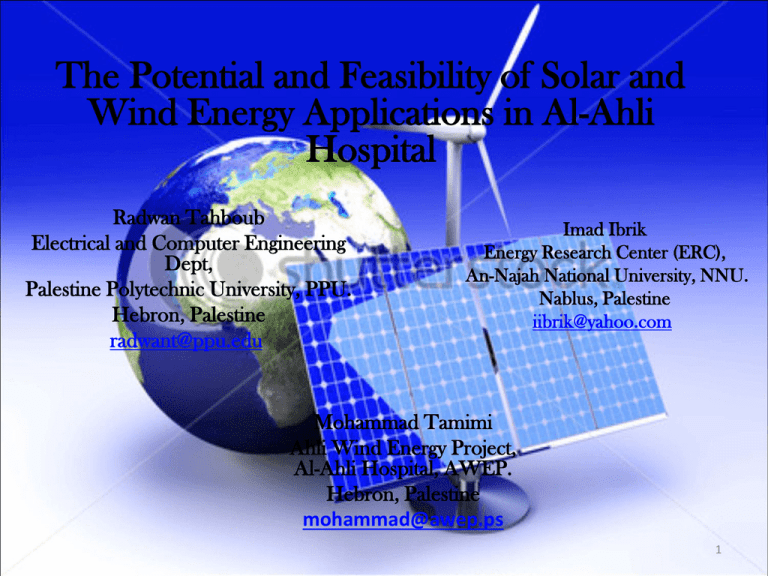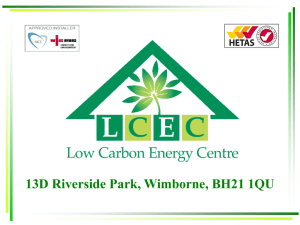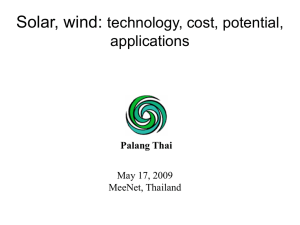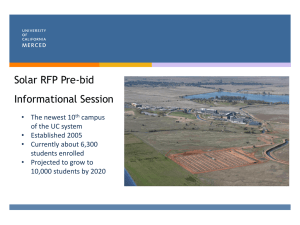kWh - awep.ps
advertisement

The Potential and Feasibility of Solar and Wind Energy Applications in Al-Ahli Hospital Radwan Tahboub Electrical and Computer Engineering Dept, Palestine Polytechnic University, PPU. Hebron, Palestine radwant@ppu.edu Imad Ibrik Energy Research Center (ERC), An-Najah National University, NNU. Nablus, Palestine iibrik@yahoo.com Mohammad Tamimi Ahli Wind Energy Project, Al-Ahli Hospital, AWEP. Hebron, Palestine mohammad@awep.ps 1 Outline • AWEP Project • AWEP Initial Design • AWEP Site Parameters and Limitations. • Detailed Analysis for Wind and Solar systems. • New Solar System Design. 2 AWEP AND AHLI • Hebron is about 850m above sea level • Good wind/solar resource. • Al-Ahli Hospital is one of the largest hospitals in Palestine (~ 500 beds), 100,000 patients per year. • It is located in the south-western part of Hebron at ~1000m above sea level on a site of 27500 m2. • Rich resource of wind/Solar energy 3 AWEP Project • Ahli Hospital Wind Energy Project (AWEP) is an innovative pilot project that involves the design and implementation of an integrated low-cost, sustainable and reliable clean energy system, with very low environmental costs, and to create public awareness as to the enormous opportunities offered by the clean energy technologies. • Main objectives was to reduce the Energy consumption by (30-40) % by using a Wind Turbine with an approximate power of 750 KW. 4 AWEP Initial Design • In 2007, – €235,000 electricity plus – €230,000 on fuel(Diesel) Yearly Diesel Consumption at Al-Ahli Hospital 400000 350000 Littre 300000 250000 200000 150000 100000 50000 0 2005 2006 2007 Years 5 AWEP INITIAL DESIGN • A wind turbine system with a total rated power of ~700KW capacity was planned to be implemented at the premises of the AlAhli Hospital (Reduces Costs by 30-40%) Wind speed (m/s) Monthly Energy Production 160000 120000 WS(m/s) Energy (kWh) 140000 100000 80000 60000 40000 20000 0 1 2 3 4 5 6 7 Month 8 9 10 11 12 8.00 7.00 6.00 5.00 4.00 3.00 2.00 1.00 0.00 1 2 3 4 5 6 7 Months 8 9 10 11 6 12 INITIAL WIND TURBINE SPECIFICATIONS. • • • • • • • Annual Wind Average 7-10 m/s Max Cut-in Wind Speed 3 - 4 m/s Cut-out Wind Speed f≈25 m/s Hub Height 45 m- 55 m Nominal Power 750 kW Lower Tower Diameter 2-5 m Upper Tower Diameter 1.5-2 m 7 AWEP Site Parameters and Limitations (CRES Findings) A. General issues. • The hospital is erected on top of a hill (latitude 31o33’22.40’’, longitude 35o04’58.63’’), • A 1 year measurement collected with a 10m meteorological mast during the period from 28/4/2009 – 8/4/2010. The 15-minutes statistics were used. • The measuring system is erected on a 10m mast on top of the hospital roof, at a distance of 30 meters from the roof edge, towards the prevailing wind direction. • a 40m high meteorological mast should have been used. 8 B. Analysis methodology • The collected data has been supplied to be analyzed in cooperation with the Center of Renewable Energy Sources and Saving (CRES). • Data analysis is made using the software WindRose© developed in CRES[3] and comprises the calculation of mean wind speed, maximum ten-minute average wind speed and the “Wind rose” graphs. • For the calculation and drawing of a wind rose, the horizontal direction is divided in 16 sectors, each 22.5o wide. • Each sector is “filled” to a level equal to the relative frequency of the times the wind blew from that particular direction during the one year period as shown in Fig.5 and Fig.6. 9 C. Environmental issues The main environmental concerns are the visual and noise impact upon the neighboring houses and primarily on the hospital itself. Evaluating the expected noise impact, the following technical characteristics should be taken into account: • The noise level produced by a typical WT may reach 100db. • At 50m downwind from the WT the expected noise level may be 57dB (±2dB); this regards the neighboring houses. • At 90m downwind from the WT the expected noise level may be 52dB (±2dB); this regards the hospital. • The above estimations regard the receptor to be at 10m a.g.l. where the wind speed is 8m/s. 10 • The analysis methodology can be summarized as: • The used two parameter Weibull distribution P (u) = (k /c) (u /c) k−1 e- (u /c) k (1) • The Weibull distribution closely depicts the statistical distribution of the collected data. 11 CRES Recommendations Centre For Renewable Energy Sources (CRES) recommended a 330 KW Wind Turbine. This leads to a saving of only 20% (Far behind 3040%) 12 Figure 5 :Al-Ahli site Wind Rose based on time. 13 Figure 6. Al-Ahli site Wind Rose based on energy. 14 Figure 7. Data distribution vs Wind Speed & Wind Direction 15 Suggested Solar System Analysis and Design According to the previous limitations, the following electrical and thermal solar system issues are considered to boost the total energy saving to 30-40 % limit: 16 a) Monthly Analysis of Electrical System for Al-Ahli Hospital Month kWh 1 2 3 4 5 6 7 8 9 10 11 12 Total 209867 202613 171787 160000 174507 230720 185613 216893 196040 207373 189240 187090 2331743 TABLE : TOTAL ELECTRICAL ENERGY CONSUMPTIONS 17 Monthly Elect. Consumption in kWh 250000 kWh 200000 150000 100000 50000 0 1 2 3 4 5 6 7 8 9 10 11 12 Month Figure 8. Monthly electrical consumption 18 b) Monthly Analysis of Current Solar Water Heater System Since 2009, the Al-Ahli Hospital has been carrying out measurements of wind speed and solar radiation using modern meteorological station equipped with all necessary automatic data loggers Month 1 2 3 4 5 6 7 8 9 10 11 12 Solar Energ- kWh/m2 2.85 3.308 4.59 6.08 6.86 7.51 7.22 7.05 5.87 4.84 3.49 2.75 TABLE : SOLAR ENERGY -KWH/M2-DAY-HEBRON-2009 19 Solar Energy -kWh/m^2-Day-Hebron-2009 8 7 6 SE 5 4 3 2 1 0 1 2 3 4 5 6 7 8 9 10 11 12 Months Figure 9. Solar Energy -kWh/m2-Day-Hebron-2009 20 The current thermal energy consumption in Al-Ahli hospital during 2009 Month 1 2 3 4 5 6 7 8 9 10 11 liter 43540 34275 30720 20844 7756 8331 10160 7107 9164 15195 20690 Eeq. (kWh) 417679 328800 294697 199957 74403 79919 97465 68177 87910 145766 198479 12 Total 25570 233352 245293 2238546 TABLE : The monthly thermal energy consumption 21 Monthly diesel consumption in equivalent kWh kWh 450000 400000 350000 300000 250000 200000 150000 100000 50000 0 1 2 3 4 5 6 7 8 9 10 11 12 Month Figure 10.The monthly thermal energy consumption in kWh 22 c) • • • • • • • • • • • • Design of the Thermal Solar System (SWHS) The hospital has buildings, which are very appropriate to be provided by solar heated water. The roofs of these buildings are totally not occupied and large enough for installation of large scale water heating systems, as well as there are no shadowing possibilities for the solar systems. A solar water heater system design will be capable to deliver the necessary hot water and to pre-heat the inlet water to feed the steam boilers as illustrated in the following points: Total daily energy required from the SWHS, 50% of the total thermal energy consumption, it means about 2.238.545X50% = 1.119.272 So we will design our SWHS (Solar Water Heating System) as to save 1,200,000 Kwh/year, this is equivalent to a saving of 53.6% (3287Kwh/day. ) Average solar radiation on horizontal surface in Palestine, 5400wh/m2/day. Area of solar collector: 2.55m2 Number of necessary solar collectors= 355 Provided each collector of this type has a production of (0.77 Kwh). Total area of the collectors: 905m2. Hot water storage tank capacity: 5X4 m3. Daily production of the SWHS= 23.0 m3 (at 70cº). Annual production of SWH= 8395.5m3. The SWHS systems should be built on buildings where enough places on the roofs are available. 23 Months 1 2 3 4 5 6 7 8 9 10 11 12 Energy producing (kWh) 59532 69168 95977 127129 143438 157034 150968 147411 122742 101204 72976 57501 TABLE : Monthly Energy producing from SWH 24 Monthly energy producing 160000 140000 120000 kWh 100000 80000 60000 40000 20000 0 1 2 3 4 5 6 7 8 9 10 11 12 Month Figure 11. Monthly Energy producing from SWH in kWh 25 d. Summary of total energy saving • Thermal Energy Consumption before SWH=2238545 kWh/year. • Thermal Energy consumption after installation of SWH= 1247184 kWh/year which equals to = 55.71% • Energy Saving at using SWH = 44.29%. 26 Mon Energy consumption (KWh) Energy producing (KWh) Energy balance -KWh 1 2 3 4 5 6 7 8 9 10 11 12 Total 417679 328800 294697 199957 74403 79919 97465 68177 87910 145766 198479 245293 2238545 59532 69168 95977 127129 143438 157034 150968 147411 122742 101204 72976 57501 1305080 358147 259632 198720 72828 -69035 -77115 -53503 -79234 -34832 44562 125503 187792 1247184 TABLE : Energy Consumption and Production balance 27 kWh Balance of Energy consumption-kWh 400000 350000 300000 250000 200000 150000 100000 50000 0 -50000 -100000 1 2 3 4 5 6 7 8 9 10 11 12 Month Figure 12 . Energy Consumption and Production balance 28 CONCLUSIONS The main objectives of this project was to reduce the Energy consumption of the hospital by 30%-40% by using a WT (Wind Turbine) with an approximate power of 750 KW, during the assessment of the site and wind potential in cooperation with CRES, a maximum of 330KW WT can be used at the site leading to a saving of only 20% of the electricity consumption of the Hospital. A suggested alternative was to install a Solar system. The alternative solar system suggested by the AWEP teams is a solar thermal system to heat the water used in the hospital for hot water, heating the building during winter and for steam generation. The overall energy saving would be as high as 40%. 29 Acknowledgment AWEP project is funded by EU commission and Al-Ahli Hospital. This project is the output of team work from different entities and organizations. Thanks to EU commission, AWEP team, Palestinian energy authorities, Hebron Municipality and Power Companies, Associate and EU partners. Thanks to all for their great contribution to the AWEP project. 30 Thank You 31







